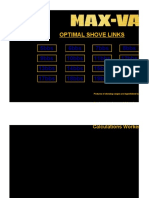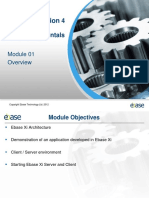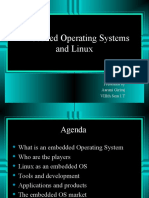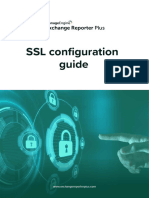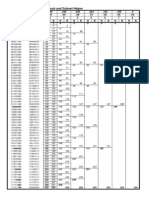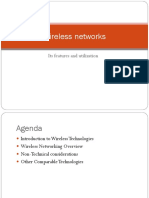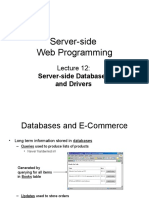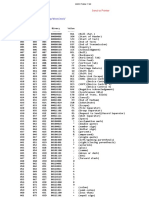02 - XML - Fundamentals
Uploaded by
Hop Huynh02 - XML - Fundamentals
Uploaded by
Hop Huynh<?xml version=1.
0> <course startdate=February 06, 2006> <title> eXtensible Markup Language </title> <lecturer>Phan Vo Minh Thang</lecturer> </course>
eXtensible Markup Language
Fundamentals
eXtensible Markup Language
Lecturer: Phan Vo Minh Thang MSc.
<?xml version=1.0> <material> XML Lectures Notes
<section id=02> XML Fundamentals </section> </material>
XML Documents and XML Files
An XML document contains text, never binary data An XML document can be opened with any program that knows how to read a text file It is usual to give a .xml extension file name MIME media type: application/xml or text/xml
<person> Alan Turing </person>
eXtensible Markup Language
Lecturer: Phan Vo Minh Thang MSc.
<?xml version=1.0> <material> XML Lectures Notes
<section id=02> XML Fundamentals </section> </material>
Elements, Tags, and Character Data
The previous example is composed of a single element named person
Start-tag: <person> End-tag: </person>
Everything between start-tag and end-tag is called content
Content encompasses real information Whitespace is part of the content, though many applications will choose to ignore it
<person> and </person> are markup Alan Turing and its surrounding whitespace are character data
eXtensible Markup Language
Lecturer: Phan Vo Minh Thang MSc.
<?xml version=1.0> <material> XML Lectures Notes
<section id=02> XML Fundamentals </section> </material>
Tag Syntax
Like XML tags
Start-tags begin with < and end-tags begin with </ Both of start-tags and end-tags are followed by the name of the element and are closed by >
You are allowed to make up new XML tags
Tag names generally reflect the type of content inside the element, not how that content will be formatted
Case sensitivity
<Person> <PERSON> <person>
eXtensible Markup Language
Lecturer: Phan Vo Minh Thang MSc.
<?xml version=1.0> <material> XML Lectures Notes
<section id=02> XML Fundamentals </section> </material>
Empty Element
Empty element: elements that have no content
For the value of their attributes
Example
<email href=mailto></email>
Shorthand notation
<email href=mailto />
eXtensible Markup Language
Lecturer: Phan Vo Minh Thang MSc.
<?xml version=1.0> <material> XML Lectures Notes
<section id=02> XML Fundamentals </section> </material>
XML Trees
Elements can contain other elements that in turn can contain text or elements and so on
Start and end tags must always be balanced and children are always completed enclosed in their parents. Use Last-In-First-Out
<name><fname>Jack</fname><lname>Smith<name></lname>
Illegal
Parent Child Sibling Each element (except the root element) has exactly one parent element An XML document is a tree of elements Root (document) element: the first element in the document and the element that contains all other elements
eXtensible Markup Language
Lecturer: Phan Vo Minh Thang MSc.
<?xml version=1.0> <material> XML Lectures Notes
<section id=02> XML Fundamentals </section> </material>
A Tree Diagram for Example 2-2
eXtensible Markup Language
Lecturer: Phan Vo Minh Thang MSc.
<?xml version=1.0> <material> XML Lectures Notes
<section id=02> XML Fundamentals </section> </material>
Tree of the Address Book
address book entry entry
name
address
tel
tel
name
tel
street
region
postalcode
locality
country
fname
lname
eXtensible Markup Language
Lecturer: Phan Vo Minh Thang MSc.
<?xml version=1.0> <material> XML Lectures Notes
<section id=02> XML Fundamentals </section> </material>
Mixed Content
The dichotomy between elements that contain only character data and elements that contain only child elements is common in data-oriented XML documents Mixed content: some elements may contain sub-elements and raw data
Common in XML documents containing articles, essays, stories, books, novels, reports, web pages document-oriented applications
Element content type:
Element content Mixed content Simple content Empty content
eXtensible Markup Language
Lecturer: Phan Vo Minh Thang MSc.
<?xml version=1.0> <material> XML Lectures Notes
<section id=02> XML Fundamentals </section> </material>
Attributes
Attach additional information to elements An attribute is a name-value pair attached to an elements start-tag
One element can have more than one attribute Name and value are separated by = and optional whitespace Attribute value is enclosed in double or single quotation marks <tel preferred=true>03-5712121</tel> Attribute order is not significant
Example 2-4
<person born=1912-06-23 died=1954-06-07> Alan Turing </person>
eXtensible Markup Language
Lecturer: Phan Vo Minh Thang MSc.
<?xml version=1.0> <material> XML Lectures Notes
<section id=02> XML Fundamentals </section> </material>
Attributes and Elements
When and whether one should use child elements or attributes to hold information?
Attributes are for metadata about the element, while elements are for the information itself
Each element may have no more than one attribute with a given name The value of attribute is simply a text string limited in structure An element-based structure is a lot more flexible and extensible If you are designing your own XML vocabulary, it is up to you to decide when to use which
eXtensible Markup Language
Lecturer: Phan Vo Minh Thang MSc.
<?xml version=1.0> <material> XML Lectures Notes
<section id=02> XML Fundamentals </section> </material>
XML Names
Rules for naming elements, attributes
May contain essentially any alphanumeric character and non-english letters, numbers, and ideograms May contain underscore(_), period (.), and hyphen (-) XML may not contain whitespace of any kind All names beginning with the string xml (in any combination of case) are reserved for standardization in W3C XML-related specifications Start with either letters. ideograms and underscore (_) No limit to the name length
eXtensible Markup Language
Lecturer: Phan Vo Minh Thang MSc.
<?xml version=1.0> <material> XML Lectures Notes
<section id=02> XML Fundamentals </section> </material>
XML Names (Cont.)
HTML elements in XML are always in uppercase XML elements are frequently written in lowercase
When a name consists of several words, the words are usually separated by a hyphen (-)
address-book
OR The first letter of each word in XML elements are frequently in uppercase and no separation character
AddressBook
eXtensible Markup Language
Lecturer: Phan Vo Minh Thang MSc.
<?xml version=1.0> <material> XML Lectures Notes
<section id=02> XML Fundamentals </section> </material>
Element names example
Which tags are named correctly?
<first.name> <xml-tag> <10things> <_oldname> <more=less>
<authors.name> <Chapter Title>
<SUV-rating> <engine:part>
<myFavoriteColor> <thingamabob> <50s.music> <the10popular> <small_version>
eXtensible Markup Language
Lecturer: Phan Vo Minh Thang MSc.
<?xml version=1.0> <material> XML Lectures Notes
<section id=02> XML Fundamentals </section> </material>
Entity References
What if the character data inside an element contains < ? Entity reference when an application parses an XML document, it replaces the entity reference with the actual characters to which the entity reference refers Entity references are markups XML predefines 5 entity references you can define more
< the less-than sign &s; the ampersand (&) > the greater-than sign " the straight, double quotation marks (") ' the straight single quote (')
eXtensible Markup Language
Lecturer: Phan Vo Minh Thang MSc.
<?xml version=1.0> <material> XML Lectures Notes
<section id=02> XML Fundamentals </section> </material>
CDATA Sections
What if your character data have a lot of <, &, ', " Enclose the character data in a CDATA section
<![CDATA[ .. ]]>
Everything inside a CDATA section is treated as raw character data not markup The only thing that cannot appear in a CDATA section is the CDATA section end delimiter ]]>
eXtensible Markup Language
Lecturer: Phan Vo Minh Thang MSc.
<?xml version=1.0> <material> XML Lectures Notes
<section id=02> XML Fundamentals </section> </material>
Comments
XML documents can be commented so that coauthors can leave notes for each other and themselves
Begin with <!-- and end with the first occurrence of --> The double hyphen -- should not appear anywhere inside the comment until the closing -->
Comments may appear anywhere in the character data of a document Comments may appear before or after the root element Comments may not appear inside a tag or inside another comment Comments are strictly for making the raw source code of an XML document more legible to human readers
eXtensible Markup Language
Lecturer: Phan Vo Minh Thang MSc.
<?xml version=1.0> <material> XML Lectures Notes
<section id=02> XML Fundamentals </section> </material>
The XML Declaration
XML documents should (but not have to) begin with an XML declaration
The XML declaration must be the first thing in the document It must not be preceded by any comments, whitespace
An XML declaration specifies encoding and standalone
Encoding: specify the character set used in the XML document
Default to Unicode/UTF8
Standalone: if the value is "no", then an application may be required to read an external DTD to determine the proper values for parts of the document
eXtensible Markup Language
Lecturer: Phan Vo Minh Thang MSc.
<?xml version=1.0> <material> XML Lectures Notes
<section id=02> XML Fundamentals </section> </material>
Rules for Well-Formed XML
Rule 1: Mandatory closing tags
The set of tags is unlimited but all container tags must have end tags
Example of legal XML
<person> <name> Phan Minh Vo Thang </name> <title> Associate Professor </title> <age> 25 </age> </person>
Rule 2: There must be exactly one root element
eXtensible Markup Language
Lecturer: Phan Vo Minh Thang MSc.
<?xml version=1.0> <material> XML Lectures Notes
<section id=02> XML Fundamentals </section> </material>
Rules for Well-Formed XML (Cont.)
Rule 3: Proper element nesting
All tags must be nested correctly. Like HTML, XML can intermix tags and text, but tags may not overlap each other. Legal XML
<person> Hao-Ren Ke is an <role> pioneer</role>for<service>Computerized Interlibrary Loan</service> in Taiwan</person>
Illegal XML
<person><name>Claven</name> <keypoint><hd>XML provides a data bus</hd> </person><more></more></keypoint>
eXtensible Markup Language
Lecturer: Phan Vo Minh Thang MSc.
<?xml version=1.0> <material> XML Lectures Notes
<section id=02> XML Fundamentals </section> </material>
Rules for Well-Formed XML (Cont.)
Rule 4: Attribute values must be single or double quoted
Legal
<tag attribute=value> <tag attribute=value>
Illegal
<font size=6>
Rule 5: An element may not have two attributes with the same name Rule 6: Comments and processing instructions may not appear inside tags Rule 7: No unescaped < or & signs may occur in the character data of an element or attributes
eXtensible Markup Language
Lecturer: Phan Vo Minh Thang MSc.
<?xml version=1.0> <material> XML Lectures Notes
<section id=02> XML Fundamentals </section> </material>
Rules for Well-Formed XML
Rule 8: Empty elements must be written in an abbreviated form using special XML syntax.
Legal
<BR /> <HR /> <TITLE></TITLE> is equivalent to <TITLE/>
Illegal
<BR> <HR>
eXtensible Markup Language
Lecturer: Phan Vo Minh Thang MSc.
<?xml version=1.0> <material> XML Lectures Notes
<section id=02> XML Fundamentals </section> </material>
Four Common Errors
Forget End Tags Forget that XML is Case Sensitive Introduce Spaces in the Name of Element Forget the Quotes for Attribute Value
eXtensible Markup Language
Lecturer: Phan Vo Minh Thang MSc.
<?xml version=1.0> <material> XML Lectures Notes
<section id=02> XML Fundamentals </section> </material>
Exercise
Is it a well-formed XML document?
<?xml version=1.0 standalone=yes?> <Book> <Title>The XML Handbook</title> <Publisher>Prentice Hall PTR </Publisher> <Author>Charles F. Goldfarb</Author> </Book>
<web-class> <Title>XML Basics</Title> <xml-professor>Carolyn Strong</xml-professor> <1st.class>April 17</1st.class > </web-class>
eXtensible Markup Language
Lecturer: Phan Vo Minh Thang MSc.
<?xml version=1.0> <material> XML Lectures Notes
<section id=02> XML Fundamentals </section> </material>
Well-formed checking using tools
eXtensible Markup Language
Lecturer: Phan Vo Minh Thang MSc.
<?xml version=1.0> <material> XML Lectures Notes
<section id=02> XML Fundamentals </section> </material>
Info
Course name:
Special Selected Topic in Information System
Section: XML Fundamentals Number of slides: 26 Updated date: 12/02/2006 Contact: Mr.Phan Vo Minh Thang
(minhthangpv@hcmuaf.edu.vn)
eXtensible Markup Language
Lecturer: Phan Vo Minh Thang MSc.
You might also like
- Embedded Operating Systems and Linux: Presented by Aaruni Giriraj Viiith Sem I.TNo ratings yetEmbedded Operating Systems and Linux: Presented by Aaruni Giriraj Viiith Sem I.T24 pages
- Network Security For Virutal Machine in Cloud ComputingNo ratings yetNetwork Security For Virutal Machine in Cloud Computing4 pages
- Windows Security: Fore Academy Security Essentials (V)No ratings yetWindows Security: Fore Academy Security Essentials (V)17 pages
- Vmware Vsphere 6.7.X On Dell Emc Poweredge Servers: Compatibility MatrixNo ratings yetVmware Vsphere 6.7.X On Dell Emc Poweredge Servers: Compatibility Matrix26 pages
- Supporting and Troubleshooting Windows 10 Outline 1No ratings yetSupporting and Troubleshooting Windows 10 Outline 12 pages
- Configure IPsec - IKE Policy For S2S VPN or VNet-To-VNet Connections - Azure Resource Manager - PowerShell - Microsoft DocsNo ratings yetConfigure IPsec - IKE Policy For S2S VPN or VNet-To-VNet Connections - Azure Resource Manager - PowerShell - Microsoft Docs12 pages
- Vsphere Esxi Vcenter Server 602 Installation Setup Guide PDFNo ratings yetVsphere Esxi Vcenter Server 602 Installation Setup Guide PDF298 pages
- Manage Azure Ad Users and Groups SlidesNo ratings yetManage Azure Ad Users and Groups Slides18 pages
- These Interview Questions With Answers Will Test Your Basic Knowledge of PC and NetworkingNo ratings yetThese Interview Questions With Answers Will Test Your Basic Knowledge of PC and Networking4 pages
- Guide To Configuring Advanced Microsoft Windows Server 2012 R2No ratings yetGuide To Configuring Advanced Microsoft Windows Server 2012 R2446 pages
- Adl Future of Enterprise Networking PDFNo ratings yetAdl Future of Enterprise Networking PDF20 pages
- Microsoft Office 365 Pro Plus Product KeyNo ratings yetMicrosoft Office 365 Pro Plus Product Key1 page
- Chapter 1 - Introduction To Blockchain TechnologyNo ratings yetChapter 1 - Introduction To Blockchain Technology10 pages
- Mastering Windows Server Group Policy & Active DirectoryNo ratings yetMastering Windows Server Group Policy & Active Directory2 pages
- Sams Asp Dotnet Evolution Isbn0672326477No ratings yetSams Asp Dotnet Evolution Isbn0672326477374 pages
- IPBS IPBL and IPVM Installation Operation Manual (9.1.X)No ratings yetIPBS IPBL and IPVM Installation Operation Manual (9.1.X)187 pages
- Windows Services - All Roads Lead To System: Kostas LintovoisNo ratings yetWindows Services - All Roads Lead To System: Kostas Lintovois21 pages
- Fundamentals of Wireless LANs Answer - 100%No ratings yetFundamentals of Wireless LANs Answer - 100%8 pages
- Configuring IPCop Firewalls: Closing Borders with Open SourceFrom EverandConfiguring IPCop Firewalls: Closing Borders with Open SourceNo ratings yet
- MCSA Windows Server 2012 R2 Complete Study Guide: Exams 70-410, 70-411, 70-412, and 70-417From EverandMCSA Windows Server 2012 R2 Complete Study Guide: Exams 70-410, 70-411, 70-412, and 70-417No ratings yet
- Network Mergers and Migrations: Junos Design and ImplementationFrom EverandNetwork Mergers and Migrations: Junos Design and ImplementationNo ratings yet
- Alcatel-Lucent Network Routing Specialist II (NRS II) Self-Study Guide: Preparing for the NRS II Certification ExamsFrom EverandAlcatel-Lucent Network Routing Specialist II (NRS II) Self-Study Guide: Preparing for the NRS II Certification ExamsNo ratings yet
- Server-Side Web Programming: The Jakarta Tomcat Web Container and The Netbeans IdeNo ratings yetServer-Side Web Programming: The Jakarta Tomcat Web Container and The Netbeans Ide38 pages
- Server-Side Web Programming: Introduction To SessionsNo ratings yetServer-Side Web Programming: Introduction To Sessions24 pages
- Server-Side Web Programming: The Request and Response ObjectsNo ratings yetServer-Side Web Programming: The Request and Response Objects15 pages
- Server-Side Web Programming: Efficient and Safe Database Access On Web ServersNo ratings yetServer-Side Web Programming: Efficient and Safe Database Access On Web Servers19 pages
- Server-Side Web Programming: Java Server Pages For Complex FormsNo ratings yetServer-Side Web Programming: Java Server Pages For Complex Forms27 pages
- Server-Side Web Programming: Formatting and InternationalizationNo ratings yetServer-Side Web Programming: Formatting and Internationalization13 pages
- Server-Side Web Programming: Input Validation and Error HandlingNo ratings yetServer-Side Web Programming: Input Validation and Error Handling40 pages
- Server-Side Web Programming: Shopping Carts and The Model-View-Control ArchitectureNo ratings yetServer-Side Web Programming: Shopping Carts and The Model-View-Control Architecture41 pages
- Server-Side Web Programming: Introduction To Java Server PagesNo ratings yetServer-Side Web Programming: Introduction To Java Server Pages23 pages
- Server-Side Web Programming: Java Servlets and The Control-View ArchitectureNo ratings yetServer-Side Web Programming: Java Servlets and The Control-View Architecture26 pages
- Suhanto Kastaredja - Listening Learning MaterialsNo ratings yetSuhanto Kastaredja - Listening Learning Materials15 pages
- (IJCST-V2I4P27) Author: Ritu, Puneet SharmaNo ratings yet(IJCST-V2I4P27) Author: Ritu, Puneet Sharma5 pages
- მიხეილ ბიჭია- კანონისმიერი ვალდებულებითი ურთიერთობებიNo ratings yetმიხეილ ბიჭია- კანონისმიერი ვალდებულებითი ურთიერთობები373 pages
- Image Compression: - Data vs. Information - Entropy - Data RedundancyNo ratings yetImage Compression: - Data vs. Information - Entropy - Data Redundancy30 pages
- Tabela ASCII Produzida Por Welder Pinheiro Luz Academics Master Blog Decimal Binário ReferênciaNo ratings yetTabela ASCII Produzida Por Welder Pinheiro Luz Academics Master Blog Decimal Binário Referência5 pages
- String - Swift Standard Library - Apple Developer DocumentationNo ratings yetString - Swift Standard Library - Apple Developer Documentation23 pages
- Embedded Operating Systems and Linux: Presented by Aaruni Giriraj Viiith Sem I.TEmbedded Operating Systems and Linux: Presented by Aaruni Giriraj Viiith Sem I.T
- Network Security For Virutal Machine in Cloud ComputingNetwork Security For Virutal Machine in Cloud Computing
- Windows Security: Fore Academy Security Essentials (V)Windows Security: Fore Academy Security Essentials (V)
- Vmware Vsphere 6.7.X On Dell Emc Poweredge Servers: Compatibility MatrixVmware Vsphere 6.7.X On Dell Emc Poweredge Servers: Compatibility Matrix
- Supporting and Troubleshooting Windows 10 Outline 1Supporting and Troubleshooting Windows 10 Outline 1
- Configure IPsec - IKE Policy For S2S VPN or VNet-To-VNet Connections - Azure Resource Manager - PowerShell - Microsoft DocsConfigure IPsec - IKE Policy For S2S VPN or VNet-To-VNet Connections - Azure Resource Manager - PowerShell - Microsoft Docs
- Vsphere Esxi Vcenter Server 602 Installation Setup Guide PDFVsphere Esxi Vcenter Server 602 Installation Setup Guide PDF
- These Interview Questions With Answers Will Test Your Basic Knowledge of PC and NetworkingThese Interview Questions With Answers Will Test Your Basic Knowledge of PC and Networking
- Guide To Configuring Advanced Microsoft Windows Server 2012 R2Guide To Configuring Advanced Microsoft Windows Server 2012 R2
- Mastering Windows Server Group Policy & Active DirectoryMastering Windows Server Group Policy & Active Directory
- IPBS IPBL and IPVM Installation Operation Manual (9.1.X)IPBS IPBL and IPVM Installation Operation Manual (9.1.X)
- Windows Services - All Roads Lead To System: Kostas LintovoisWindows Services - All Roads Lead To System: Kostas Lintovois
- Configuring IPCop Firewalls: Closing Borders with Open SourceFrom EverandConfiguring IPCop Firewalls: Closing Borders with Open Source
- MCSA Windows Server 2012 R2 Complete Study Guide: Exams 70-410, 70-411, 70-412, and 70-417From EverandMCSA Windows Server 2012 R2 Complete Study Guide: Exams 70-410, 70-411, 70-412, and 70-417
- Network Mergers and Migrations: Junos Design and ImplementationFrom EverandNetwork Mergers and Migrations: Junos Design and Implementation
- Alcatel-Lucent Network Routing Specialist II (NRS II) Self-Study Guide: Preparing for the NRS II Certification ExamsFrom EverandAlcatel-Lucent Network Routing Specialist II (NRS II) Self-Study Guide: Preparing for the NRS II Certification Exams
- Server-Side Web Programming: The Jakarta Tomcat Web Container and The Netbeans IdeServer-Side Web Programming: The Jakarta Tomcat Web Container and The Netbeans Ide
- Server-Side Web Programming: Introduction To SessionsServer-Side Web Programming: Introduction To Sessions
- Server-Side Web Programming: The Request and Response ObjectsServer-Side Web Programming: The Request and Response Objects
- Server-Side Web Programming: Efficient and Safe Database Access On Web ServersServer-Side Web Programming: Efficient and Safe Database Access On Web Servers
- Server-Side Web Programming: Java Server Pages For Complex FormsServer-Side Web Programming: Java Server Pages For Complex Forms
- Server-Side Web Programming: Formatting and InternationalizationServer-Side Web Programming: Formatting and Internationalization
- Server-Side Web Programming: Input Validation and Error HandlingServer-Side Web Programming: Input Validation and Error Handling
- Server-Side Web Programming: Shopping Carts and The Model-View-Control ArchitectureServer-Side Web Programming: Shopping Carts and The Model-View-Control Architecture
- Server-Side Web Programming: Introduction To Java Server PagesServer-Side Web Programming: Introduction To Java Server Pages
- Server-Side Web Programming: Java Servlets and The Control-View ArchitectureServer-Side Web Programming: Java Servlets and The Control-View Architecture
- მიხეილ ბიჭია- კანონისმიერი ვალდებულებითი ურთიერთობებიმიხეილ ბიჭია- კანონისმიერი ვალდებულებითი ურთიერთობები
- Image Compression: - Data vs. Information - Entropy - Data RedundancyImage Compression: - Data vs. Information - Entropy - Data Redundancy
- Tabela ASCII Produzida Por Welder Pinheiro Luz Academics Master Blog Decimal Binário ReferênciaTabela ASCII Produzida Por Welder Pinheiro Luz Academics Master Blog Decimal Binário Referência
- String - Swift Standard Library - Apple Developer DocumentationString - Swift Standard Library - Apple Developer Documentation

